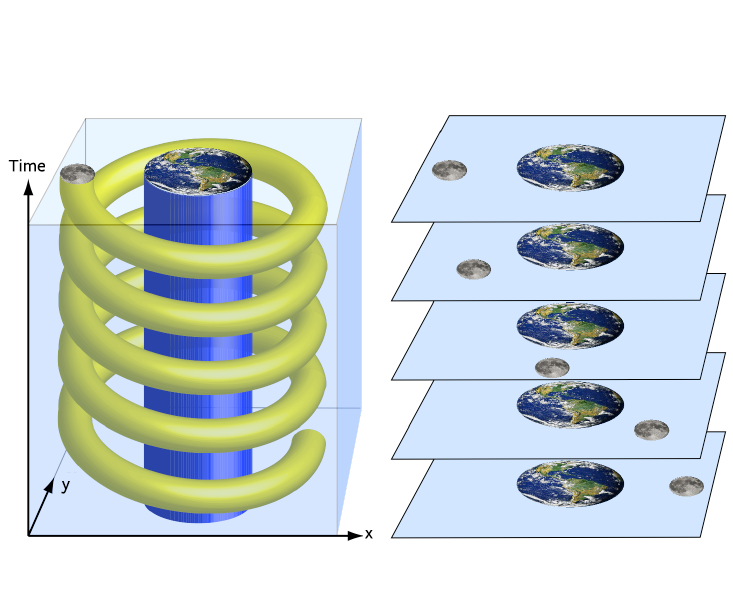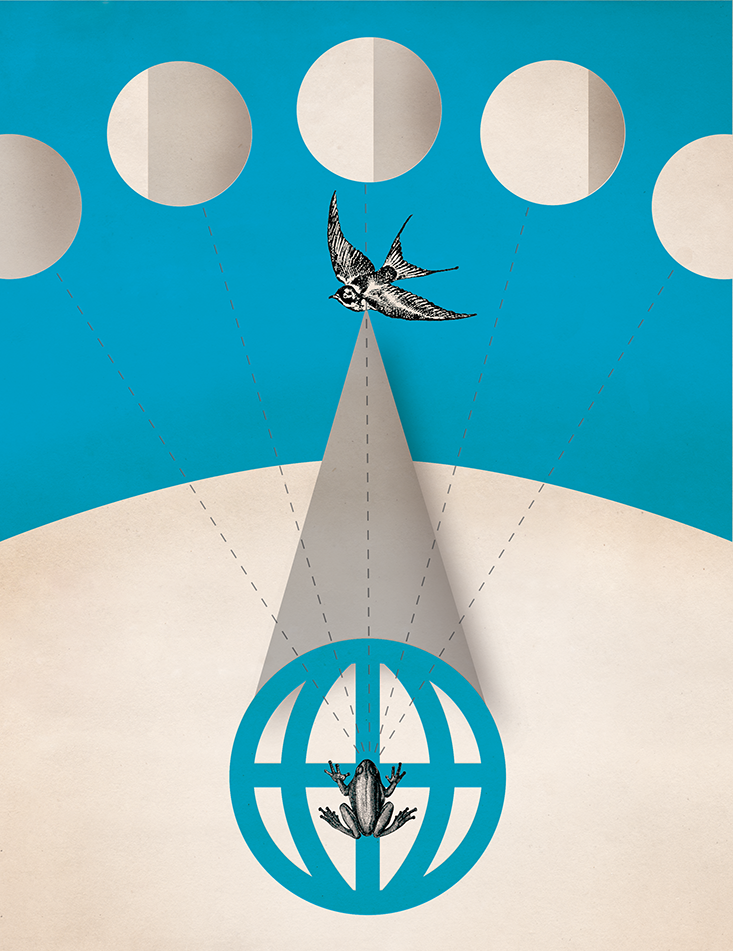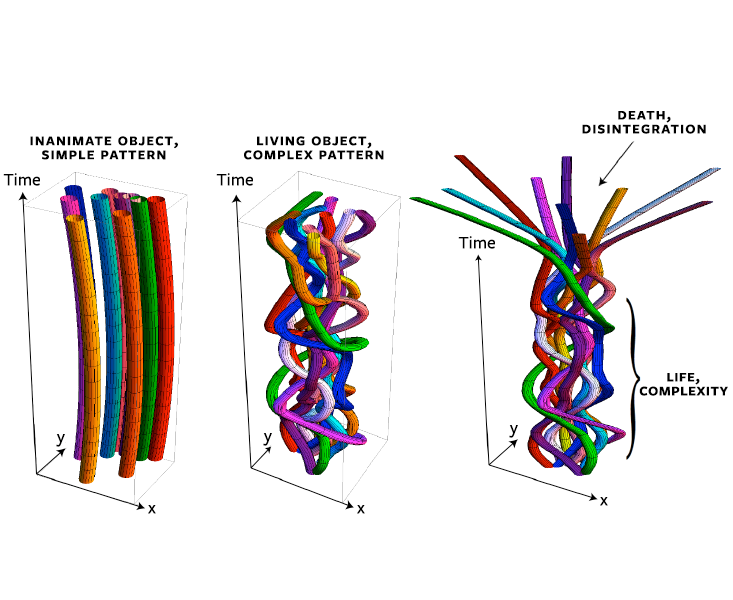Excuse me, but what’s the time?” I’m guessing that you, like me, are guilty of having asked this question, as if it were obvious that there is such a thing as the time. Yet you’ve probably never approached a stranger and asked, “Excuse me, but what’s the place?”. If you were hopelessly lost, you’d probably instead have said something like, “Excuse me, but where am I?” thereby acknowledging that you’re not asking about a property of space, but rather about a property of yourself. Similarly, when you ask for the time, you’re not really asking about a property of time, but rather about your location in time.
But that is not how we usually think about it. Our language reveals how differently we think of space and time: The first as a static stage, and the second as something flowing. Despite our intuition, however, the flow of time is an illusion. Einstein taught us that there are two equivalent ways of thinking about our physical reality: Either as a three-dimensional place called space, where things change over time, or as a four-dimensional place called spacetime that simply exists, unchanging, never created, and never destroyed.
I think of the two viewpoints as the different perspectives on reality that a frog and a bird might take. The bird surveys the landscape of reality from high “above,” akin to a physicist studying the mathematical structure of spacetime as described by the equations of physics. The frog, on the other hand, lives inside the landscape surveyed by the bird. Looking up at the moon over time, the frog sees something like the right panel in the figure, “The Moon’s Orbit”: Five snapshots of space with the Moon in different positions each time. But the bird sees an unchanging spiral shape in spacetime, as shown in the left panel.

For the bird—and the physicist—there is no objective definition of past or future. As Einstein put it, “The distinction between past, present, and future is only a stubbornly persistent illusion.” When we think about the present, we mean the time slice through spacetime corresponding to the time when we’re having that thought. We refer to the future and past as the parts of spacetime above and below this slice.
This is analogous to your use of the terms here, in front of me, and behind me to refer to different parts of spacetime relative to your present position. The part that’s in front of you is clearly no less real than the part behind you—indeed, if you’re walking forward, some of what’s presently in front of you will be behind you in the future, and is presently behind various other people. Analogously, in spacetime, the future is just as real as the past—parts of spacetime that are presently in your future will, in your future, be in your past. Since spacetime is static and unchanging, no parts of it can change their reality status, and all parts must be equally real.
The idea of spacetime does more than teach us to rethink the meaning of past and future. It also introduces us to the idea of a mathematical universe. Spacetime is a purely mathematical structure in the sense that it has no properties at all except mathematical properties, for example the number four, its number of dimensions. In my book Our Mathematical Universe, I argue that not only spacetime, but indeed our entire external physical reality, is a mathematical structure, which is by definition an abstract, immutable entity existing outside of space and time.
The most interesting property of your spacetime tube isn’t its bulk shape, but its internal structure, which is remarkably complex.
What does this actually mean? It means, for one thing, a universe that can be beautifully described by mathematics. That this is true for our universe has become increasingly clear over the centuries, with evidence piling up ever more rapidly. The latest triumph in this area is the discovery of the Higgs boson, which, just like the planet Neptune and the radio wave, was first predicted with a pencil, using mathematical equations.
That our universe is approximately described by mathematics means that some but not all of its properties are mathematical. That it is mathematical means that all of its properties are mathematical; that it has no properties at all except mathematical ones. If I’m right and this is true, then it’s good news for physics, because all properties of our universe can in principle be understood if we are intelligent and creative enough. It also implies that our reality is vastly larger than we thought, containing a diverse
collection of universes obeying all mathematically possible laws of physics.
This novel way of viewing both spacetime and the stuff in it implies a novel way of viewing ourselves. Our thoughts, our emotions, our self-awareness, and that deep existential feeling “I am”—none of this feels the least bit mathematical to me. Yet we too are made of the same kinds of elementary particles that make up everything else in our physical world, which I’ve argued is purely mathematical. How can we reconcile these two perspectives?

The first step is to consider how we look as a spacetime structure. The cosmology pioneer George Gamow entitled his autobiography My World Line, a phrase also used by Einstein to refer to paths through spacetime. However, your own world line strictly speaking isn’t a line: It has a non-zero thickness and it’s not straight. The roughly 1029 elementary particles (quarks and electrons) that your body is made of form a tube-like shape through spacetime, analogous to the spiral shape of the Moon’s orbit (“The Moon’s Orbit”) but more complicated. If you’re swimming laps in a pool, that part of your spacetime tube has a zig-zag shape, and if you’re using a playground swing, that part of your spacetime tube has a serpentine shape.
However, the most interesting property of your spacetime tube isn’t its bulk shape, but its internal structure, which is remarkably complex. Whereas the particles that constitute the Moon are stuck together in a rather static arrangement, many of your particles are in constant motion relative to one another. Consider, for example, the particles that make up your red blood cells. As your blood circulates through your body to deliver the oxygen you need, each red blood cell traces out its own unique tube shape through spacetime, corresponding to a complex itinerary though your arteries, capillaries, and veins with regular returns to your heart and lungs. These spacetime tubes of different red blood cells are intertwined to form a braid pattern as seen in the figure “Complexity and Life” which is more elaborate than anything you’ll ever see in a hair salon: Whereas a classic braid consists of three strands with perhaps thirty thousand hairs each, intertwined in a simple repeating pattern, this spacetime braid consists of trillions of strands (one for each red blood cell), each composed of trillions of hair-like elementary-particle trajectories, intertwined in a complex pattern that never repeats. In other words, if you imagine spending a year giving a friend a truly crazy hairdo, braiding the hair by separately intertwining all their individual hairs, the pattern you’d get would still be very simple in comparison.

Yet the complexity of all this pales in comparison to the patterns of information processing in your brain. Your roughly 100 billion neurons are constantly generating electrical signals (“firing”), which involves shuffling around billions of trillions of atoms, notably sodium, potassium, and calcium ions. The trajectories of these atoms form an extremely elaborate braid through spacetime, whose complex intertwining corresponds to storing and processing information in a way that somehow gives rise to our familiar sensation of self-awareness. There’s broad consensus in the scientific community that we still don’t understand how this works, so it’s fair to say that we humans don’t yet fully understand what we are. However, in broad brush, we might say this: You’re a pattern in spacetime. A mathematical pattern. Specifically, you’re a braid in spacetime—indeed, one of the most elaborate braids known.
Some people find it emotionally displeasing to think of themselves as a collection of particles. I got a good laugh back in my 20s when my friend Emil addressed my friend Mats as an “atomhög,” Swedish for “atom heap,” in an attempt to insult him. However, if someone says “I can’t believe I’m just a heap of atoms!’’ I object to the use of the word “just”: the elaborate spacetime braid that corresponds to their mind is hands down the most beautifully complex type of pattern we’ve ever encountered in our universe. The world’s fastest computer, the Grand Canyon or even the Sun—their spacetime patterns are all simple in comparison.
At both ends of your spacetime braid, corresponding to your birth and death, all the threads gradually separate, corresponding to all your particles joining, interacting and finally going their own separate ways (As seen in the right panel of “Complexity and Life”). This makes the spacetime structure of your entire life resemble a tree: At the bottom, corresponding to early times, is an elaborate system of roots corresponding to the spacetime trajectories of many particles, which gradually merge into thicker strands and culminate in a single tube-like trunk corresponding to your current body (with a remarkable braid-like pattern inside as we described above). At the top, corresponding to late times, the trunk splits into ever finer branches, corresponding to your particles going their own separate ways once your life is over. In other words, the pattern of life has only a finite extent along the time dimension, with the braid coming apart into frizz at both ends.
This view of ourselves as mathematical braid patterns in spacetime challenges the assumption that we can never understand consciousness. It optimistically suggests that consciousness can one day be understood as a form of matter, a derivative of the most beautifully complex spacetime structure in our universe. Such understanding would enlighten our approaches to animals, unresponsive patients, and future ultra-intelligent machines, with wide-ranging ethical, legal, and technological implications.
This is how I see it. However, although this idea of an unchanging reality is venerable and dates back to Einstein, it remains controversial and subject to vibrant scientific debate, with scientists I greatly respect expressing a spectrum of views. For example, in his book The Hidden Reality, Brian Greene expresses unease toward letting go of the notions change and creation as fundamental, writing, “I’m partial to there being a process, however tentative […] that we can imagine generating the multiverse.” Lee Smolin goes further in his book Time Reborn, arguing that not only is change real, but that time may be the only thing that’s real. At the other end of the spectrum, Julian Barbour argues in his book The End of Time not only that change is illusory, but that one can even describe physical reality without introducing the concept of time at all.
If we discover the ultimate nature of time, this will answer many of the most exciting open questions facing physics today. Did time have some sort of beginning before our Big Bang? Will it ultimately end? Did it emerge out of some sort of timeless quantum fuzz into which it will eventually dissolve? We physicists haven’t found the mathematical theory of quantum gravity required to convincingly answer these questions, but whatever this “theory of everything” turns out to be, time will be the key to unlocking its mysteries.
Max Tegmark is an MIT physics professor who has authored more than 200 technical papers. Known as “Mad Max” for his unorthodox ideas and passion for adventure, his scientific interests range from precision cosmology to the ultimate nature of reality, all explored in his new popular science book Our Mathematical Universe.



























